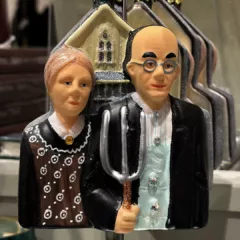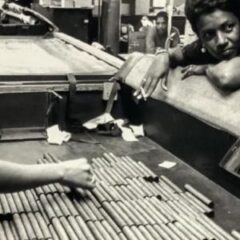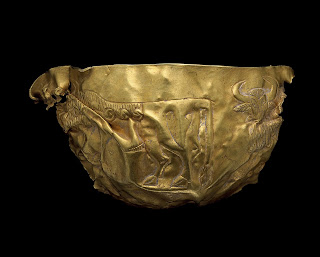
Fragment of a bowl depicting bearded bulls, Tepe Fullol, gold (2200-1900 B.C.) National Museum, Kabul, photo © Thierry Ollivier/Musée Guimet. This was part of a burial cache accidentally discovered by farmers in 1966. The motif comes from Mesopotamia, confirming an ancient trade route.
For most of us the name Afghanistan brings thoughts primarily of war. My associations prior to the past three decades’ conflicts were twofold: that most of the world’s lapis lazuli has always come from Afghanistan (in addition to its use in jewelry and precious objects the stone was finely ground to produce ultramarine, the most stable, beautiful and valuable of blue pigments); and the isolation and inaccessibility of the country in modern times as so memorably described by the rare visitor such as Eric Newby, in his classic travel narrative, A Short Walk in the Hindu Kush (1958).
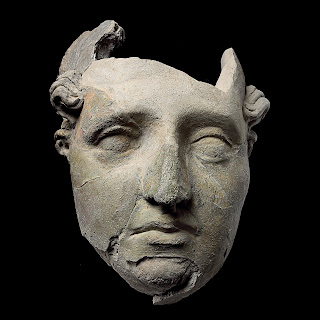
Male or female head, Aï Khanum, unfired clay (2nd century B.C.), National Museum, Kabul, photo © Thierry Ollivier/Musée Guimet. Found in the principal temple at Aï Khanum, this head belonged to a statue that stood between the vestible and the cult room.
Afghanistan; Hidden treasures from the National Museum, Kabul, at the National Gallery of Art through September 7, 2008 should dramatically change our view of the country (East Coast visitors will have a second chance when the exhibition goes to the Metropolitan Museum of Art from June 23-September, 2009 after stops in Houston and San Francisco). Its artifacts of gold, bronze, stone and glass make clear that from pre-history through the 3rd century A.D. Afghanistan was at the crossroads of the world’s most sophisticated cultures.
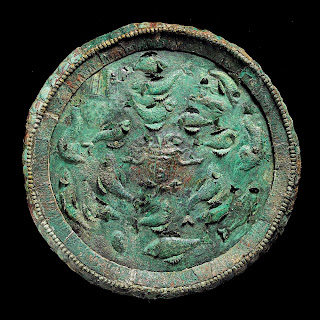
Circular basin decorated with fish, Begram (1st century A.D.), bronze, National Museum, Kabul, photo © Thierry Ollivier/Musée Guimet. One of the most delightful pieces in the exhibition, the fish have articulated fins and tails that move via counterweights. When the bowl was filled with water, it would give the impression that the fish were swimming. An elaborate joke for the guests!
Numerous stories are bound up in the exhibition. The most recent concerns the survival of these artifacts. The National Museum and its collections suffered greatly through war and political turmoil: thefts, looting, a rocket attack and a later attack during which the roof was set on fire. After the Soviet invasion of December, 1979 many of the most valuable pieces were fortunately removed and placed in vaults in the presidential palace and at the Ministry of Information and Culture; but two decades later their fate was unknown. Only in 2004 were the vaults opened and the treasures found intact, a celebratory occasion recorded in a short film shown in the exhibition. The motto of the National Museum, Kabul is A nation stays alive when its culture stays alive, and the antiquities that the Afghan people have lent testify to the vitality of a nation with an extraordinarily rich history.

Statuette of a woman standing on a makara, Begram, ivory ( 1st-2nd centuries A.D.), National Museum, Kabul, photo © Thierry Ollivier/Musée Guimet. This statuette once decorated a piece of furniture and may represent the Indian river goddess Ganga standing on a mythical creature.
A slightly older story concerns the pieces’ excavation. The exhibition includes work from four sites: gold bowls from bronze age Tepe Fullol; bronzes, stone pieces and a gilded silver plaque from the former Greek colony of Aï Khanum (3rd century B.C to first century A.D.); first-century ivories, bronzes and glass pieces from Begram; and gold burial ornaments, known as the Bactrian Hoard, from the second-century site at Tillya Tepe. None of the work had been known until the Twentieth Century; all the sites were discovered and excavated between 1936 and 1979 by archaeologists variously from France, the Soviet Union and Afghanistan.
The objects themselves tell stories of a land overrun by one group or another throughout a long history. Cyrus the Great conquered Afghanistan in 519 B.C. and made it part of the Persian Empire. When Alexander the Great conquered the Persians (334-323 B.C.), northern Afghanistan, then known as Bactria, became the furthest Eastern point of the Greek Empire. And in 145 B.C. the area was invaded by nomadic tribes from the steppes. Each invader brought his own visual culture.
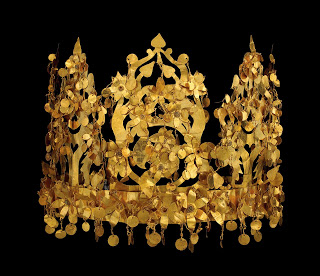
Then there is the story of trade. Afghanistan was involved in international trade as early as the bronze age: one of the Tepe Fullol bowls (above) has decoration of bearded bulls, a motif from Mesopotamia which is separated by 1,200 miles of mountains and desert. The area was later at the center of the trade route stretching from China to the Mediterranean known as the Silk Road. So it should not surprise us that Afghanistan’s treasures at times reflect stylistic influences of Greece, Rome, India and China. While the Afghans have every reason to see these treasures as a source of pride, they undercut any simple or essentialist notion of culture. The exhibition not only displays artistic treasures from a cosmopolitan culture but reminds us that the impact of global trade has an ancient history and pre-history.

Pair of pendants depicting the “Dragon Master” Tillya Tepe, gold, tourquoise, garnet, lapis lazuli, carnelian and pearl (1st century B.C.-1st century A.D.), photo © Thierry Ollivier/Musée Guimet. The figure wears a tunic and flowing pants typical of nomadic dress. He holds two dragon-like creatures, a scene found in ancient Persian and Siberian art.
The exhibition was organized jointly by the National Gallery and the National Geographic Society and each has an interactive website supporting it (here and here).


